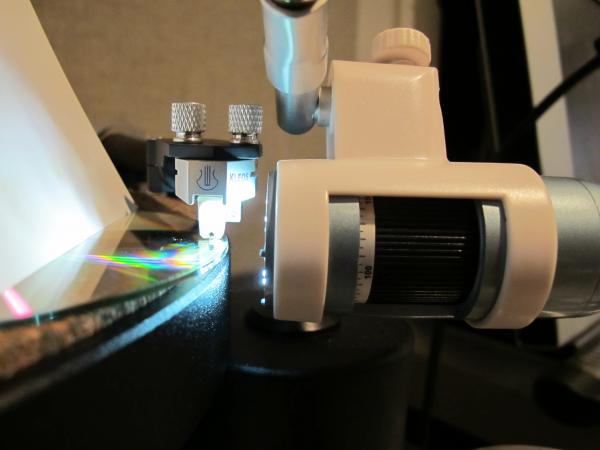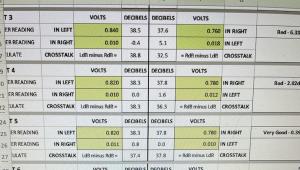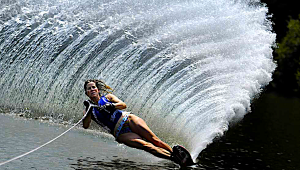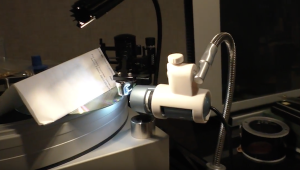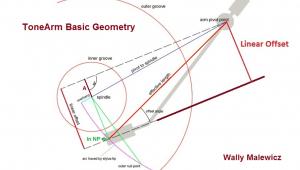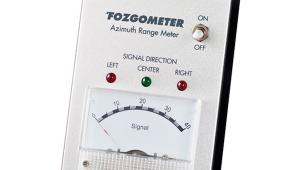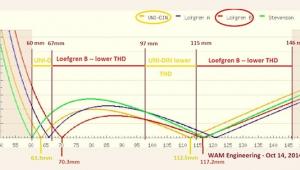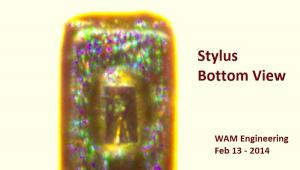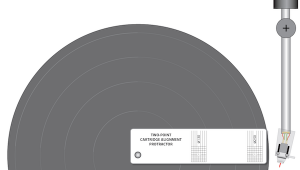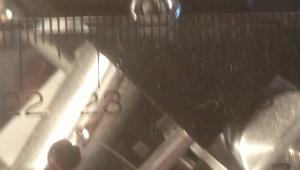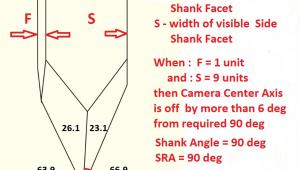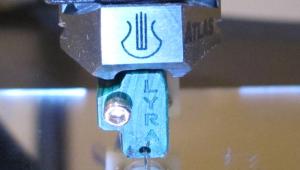How to Use a USB Digital Microscope to set 92 Degree Stylus Rake Angle (SRA)
These “severe” stylus profiles have the ability to more accurately trace the vertical modulations made by the sickle-like lacquer cutting stylus that is offset from true vertical and thus produces an angled cut, but if they are not properly aligned they bang into the vertical modulations rather than track them.
The more accurately the playback stylus replicates the cutter stylus angle, the less IM (Intermodulation Distortion) is produced, resulting in smoother yet far more detailed sound. Setting SRA by “ear” usually meant going from brighter, harder sound when set too high, to duller, thicker and less focused sound when set too low.
Once we began examining styli under the microscope it became obvious that finding the “sweet spot” was often a matter of luck and that often it would be impossible using the conventional “arm parallel to the record surface” starting position.
That’s because we found that the angle at which the stylus gets inserted into the cantilever varies widely even among samples of the same cartridge! So it’s hardly useful when a manufacturer says “start with the arm parallel to the record surface and move slightly up or down from there,” unless you can be sure the stylus has been inserted according to “spec” in the first place.
The pioneer in using digital microscopy to set SRA—at least for me— is Mr. Wally Malewicz, a Minnesota based mechanical engineer and vinyl fanatic who has been instrumental in my analog technical education over the past decade.
Why is 92 degree SRA the way to go? Please download and read this article, originally published in Audio magazine. Thanks to the Bonnier corporation’s generosity, we’ve gotten permission to offer it to you.
I believe it will convince most everyone that 92 degrees (two degrees beyond perpendicular to the record surface) is the ideal stylus rake angle. Considering that to change by one degree the SRA on a nine-inch arm requires a four millimeter height change at the pivot end, that setting should be fine regardless of record thickness.
The USB digital microscope I use is the Dino-Lite AMT313. It costs $249 and that includes MAC/PC compatible software. Dino-Lite makes numerous models and there are other companies making such devices but this is the one recommended to me. Resolution is 640x480 pixels (VGA). Magnification is continuously adjustable from between 10 to 200x.
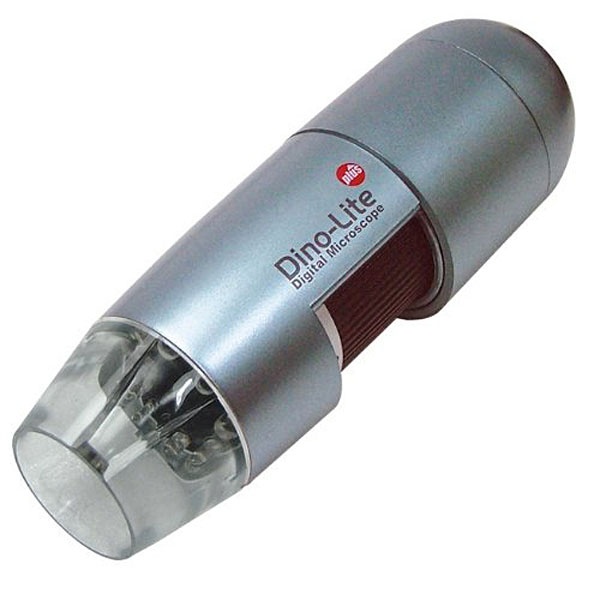
You’ll also need to purchase a microscope stand. I use the BigCatch Accessories series MS32W Articulating desktop stand ($40), but you can find others through a web search.
The first step in using the AMT313 or whichever model you choose is to remove the clear plastic LED shield ring. Unless you remove it you cannot get close enough to the stylus to get a good picture. It’s held in place with an adhesive—probably Cyanoacrylate (AKA “Crazy Glue”).
To remove the shield, use both of your thumbs and gently put pressure on the side of the shield. Then rotate the microscope and repeat on the opposite side. You’ll need to go back and forth numerous times applying moderate pressure until nothing happens and the process begins driving you crazy! Don’t give up! Just keep doing it. Eventually the shield will pop off.
Next, install the software on your computer using the CD-ROM and be sure to check to make sure the software that came in the box is up to date (you can find the Dino-Lite website online). After opening the program, connect the microscope’s USB plug into your computer—preferably a laptop you can position close to your turntable. You will have to work your way through the software, which is slightly different for Windows and MAC. Set up via the program’s preferences where you want the pictures you take to be stored, etc.
The LED ring around the microscope lens should light when you connect it to the computer’s USB port. If not click the ring icon you’ll see above where it says “picture/video” and it will light.
Now here’s the difficult part: set the microscope’s knurled ring to 175x magnification and secure it in the stand you’ve purchased (alternatively, you can use a tripod to which you’ve clipped a beam of some kind to which you attach the microscope).
Make sure you start with the tonearm parallel to the platter however you do that (the Graham Phantom Supreme II has a built in spirit level for instance).
Place the shiny side of a CD on the platter so that it protrudes slightly from the platter’s edge and carefully lower the stylus onto it. Then move the arm so the stylus is as close to the CD’s edge as you can manage. Be very careful now!
This is where it gets both tricky and dangerous so proceed with caution and watch what you do! That said, I’ve never damaged a stylus doing this and neither should you, but you have to exercise great care at all times, particularly as you shift focus from the image on the computer screen to the cartridge and microscope.
Now, maneuver the microscope and stand so that the microscope is very close to and parallel to the platter and the center of the lens bisects the edge of the CD vertically, while the stylus and cantilever bisect the lens horizontally. You should be able to see the CD’s edge and the stylus and cantilever as well on the screen. Remember: because of the large amount of magnification, a tiny movement of the microscope produced huge image movement. If the edge of the CD is not perfectly level, re-position the gooseneck or carefully rotate the microscope within the stand’s holder until it is. That is absolutely essential to getting a good picture and an accurate measurement.
If you see only black, try moving the microscope up and down either using the stand’s knurled ring or by bending the gooseneck until you see something!. Again, this part can be very frustrating and you have to be very careful. Once you have the edge of the CD in sight, carefully and slowly move the CD forward and back until the edge is perfectly focused on the screen and dead level.
Next carefully slide the stylus on the CD until it is very close to the edge of the CD so that it too is equally in focus. You should be able to see the tip of the stylus resting on the CD, not from above or below, but from directly on the CD’s edge (I may not be describing this as precisely as either of us would like, but the photos should help). Also make sure the view of the stylus is purely from the side and not angled from the front or rear. And make sure you have the stylus at the very left side of the screen so you can capture as much of the cantilever as possible. A learning curve is definitely part of this experience so don’t get frustrated if you have trouble at first and many times thereafter!
Now, to brighten the background and put the image in better relief, fold in half a small piece of white paper and place it behind the headshell area. Adjust the lighting as necessary to produce the best image—as close to the image provided here.
Now click the computer program’s camera icon and the image will be captured and appear in the gallery on the left side of the window. Click on it and it will open as an enlarged image. On the left side above the photo, type in the “input mag” (magnification) number corresponding to the knurled ring magnification ring on the USB microscope.
You will also note to the left of the picture another window called “magnifying glass”. As you move the cursor over the big photo, you’ll see a greatly magnified version of the image in the smaller window.
Now enable the measuring tool in the dropdown window that will say “Tools Disabled” and select “3 point angle.” It is extremely difficult to describe how to best use this tool, but just play with it because the red lines it draws are easily removed using the “Clear” drop down box.
You can get an approximate SRA by drawing a line through the center of the stylus (for a cartridge with a centered contact patch!) and ending it precisely at the the tip and then one from the tip across the surface of the CD. The software will calculate the angle.
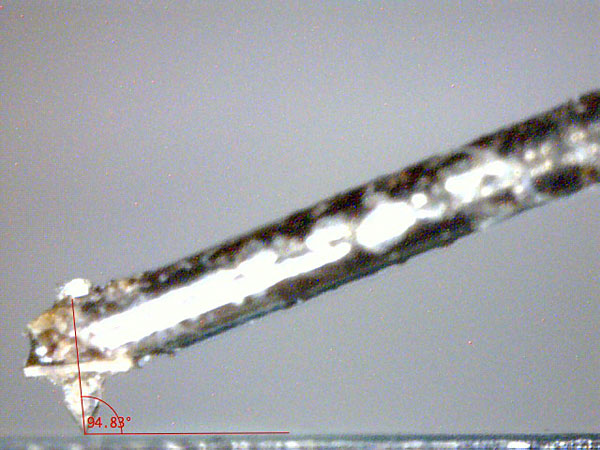
Or you can do it another way. This time beginning by measuring the leading edge angle and then the trailing edge angle (again this works only when the contact patch is centered). You want to end up with a measured angle as shown in the picture below:
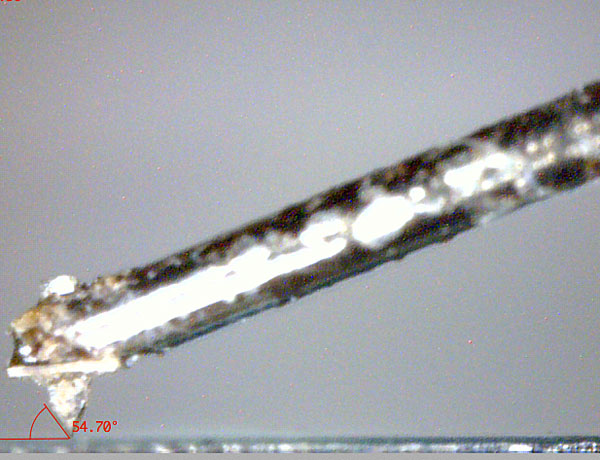
Be sure to terminate the angled line right at the stylus tip/CD surface interface. Use the smaller magnifying window to be sure. Write down that angle (here it’s 54.70 degrees) and then clear the picture. Then measure the angle of the other side of the stylus and the record surface (59.38 degrees).
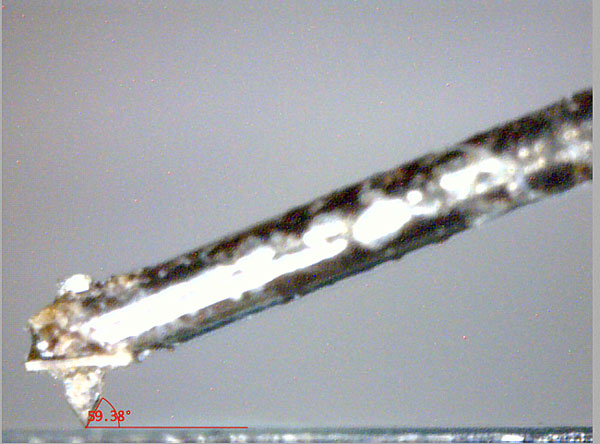
To measure the SRA of a stylus type where the contact area bisects the stylus side, start with 180 degrees, subtract the first measured angle (54.70), add the second measured angle (59.38) and divide by two: 180-54.70= 125.3 + 59.38=184.68/2= 92.34.
Try it a second time and you’re likely to get different results—as I did using the two different measurement techniques. There’s a certain amount of subjectivity to this and also a skill set that depends on the quality of the image you capture and your skills with the tools. At the very least you’ll find out if you’re in the 92 degree ballpark.
There’s another alternative though. If you send Mr. Malewicz your image (wwmalewi@aol.com), he’ll give you the approximate SRA assuming the image is reasonably close to what’s necessary to measure accurately.
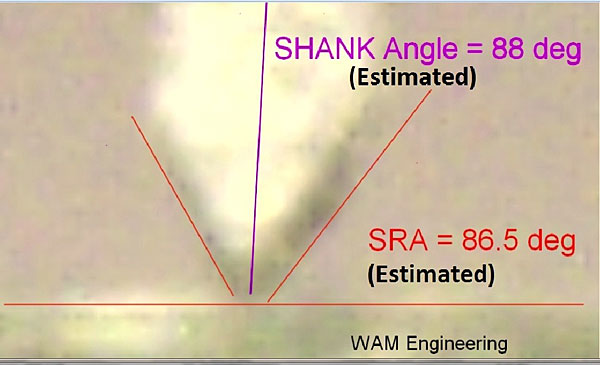
Or for $30.00, assuming your image passes his accuracy criteria, he will give you a precise measurement. But that image should look like this and that will take some practice and skill to achieve
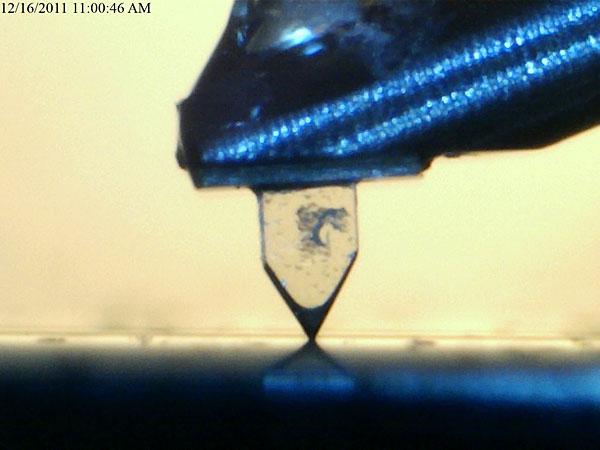
If you capture the image correctly and use the software reasonably accurately you will know where your SRA is set within a few degrees at worst, or precisely at best. You'll also find out if your cartridge's stylus/cantilever assembly comes close to spec, or is so far off, you'd have to angle the arm way down or way up to approximate 92 degrees.
That’s all there is to it. (right!)
